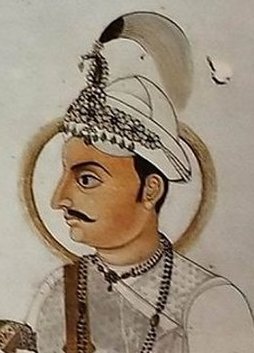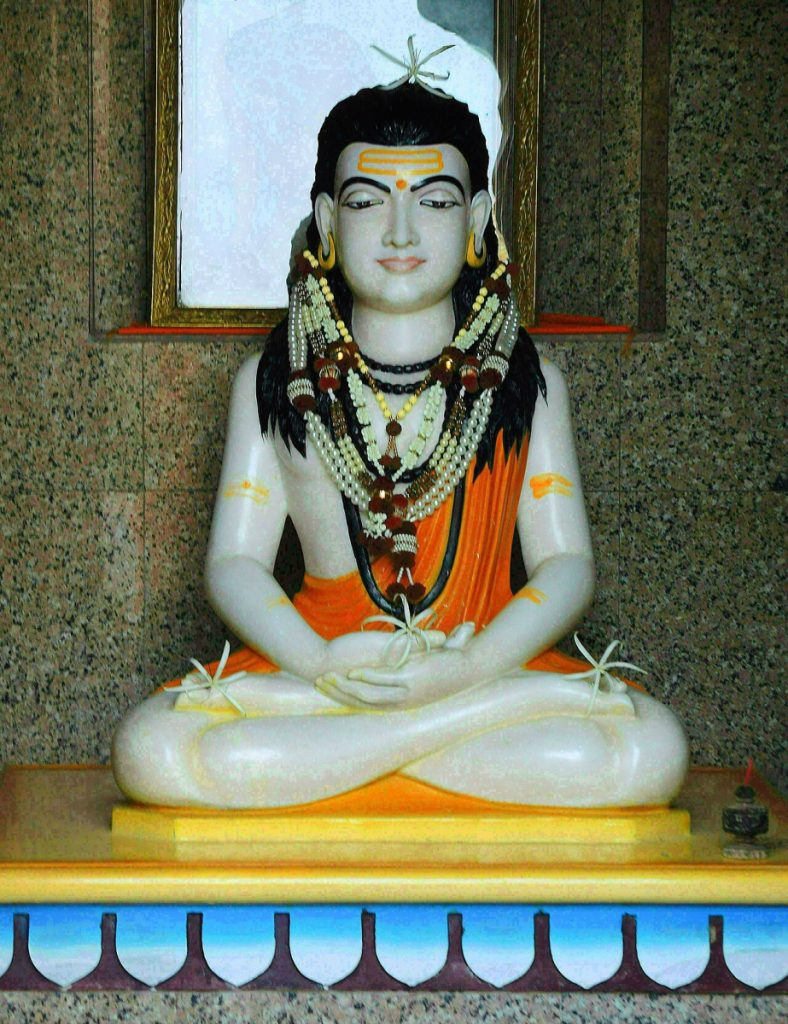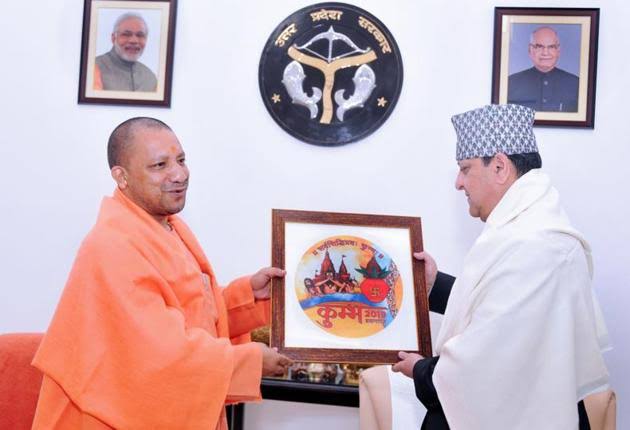
New Delhi: In October 2016, months before he assumed the top post in Uttar Pradesh, Adityanath was in Kathmandu in Nepal attending a Virat Hindu Mahasammelan or grand Hindu conference organised by the right-wing group Vishwa Hindu Mahasangh.
The event, inaugurated by the former monarch Gyanendra Bir Bikram Shah, endorsed the idea of the restoration of Nepal as a ‘Hindu’ country. It was aimed at garnering support for the return of Nepal’s Hindu monarchy, which was abolished in 2008 after a long period of Maoist struggle and political instability.
With former monarch Gyanendra Shah on stage, Adityanath, then a Member of Parliament, floated concerns about a “conspiracy” to deprive Nepal of its “Hindu Raja,” who, he said, was “recognised and respected” by Hindus across the globe. Adityanath, a monk-politician and head priest of the Gorakhnath Temple in Gorakhpur, said it was the duty of the people of Nepal to play a role in the “resurrection” of the tradition of the rule of the Shah dynasty, whose kings had presided over the country for more than 250 years. Adityanath argued that it was because of the monarchy that Nepal, unlike its neighbours, had managed to retain its independence. “The Shah royal dynasty is the symbol of Nepal’s unity and integrity,” said Adityanath.

The oldest portrait of Prithvi Narayan Shah found by historian Baburam Acharya. Painted during the king’s reign. Photo: Public Domain, Wikimedia Commons.
In a 17-minute long speech, Adityanath had compared the situation in Nepal to other countries which had combined democracies with monarchies or constitutional monarchies. If Switzerland, Britain, Thailand, Denmark, Netherlands and Japan could retain their monarchies while being democracies, why was Nepal, where 85% of the people either followed Hinduism or Hinduism-like traditions, not able to build its “Hindu identity,” asked Adityanath. “The Hindu nation formed by Prithvi Narayan Shah (the Gorkha king who unified Nepal) is crying out to every Hindu, asking what did it do that Nepal’s Hindu identity is being erased,” said Adityanath.
He repeated a popular pro-monarchy slogan in Nepal. “Hamro raja, mamro desh pran banda pyaro cha (Our king, our country are dearer than life itself).”
The event in Kathmandu provides us an insight into what Adityanath thinks about the Nepal issue. To Adityanath, Nepal is a Hindu kingdom – the only one in the world – with a long history of monarchy that has been progressively losing its Hindu cultural identity due to a long streak of political upheavals, takeover by the Maoists and transformation into a secular republic.
Almost nine years after the Kathmandu event – one of the many attended by Adityanath in the neighbouring country before and after – the Bharatiya Janata Party leader recently caused a stir in the international media through his virtual appearance at a rally in Kathmandu.
Seen at Kathmandu today: mass gathered at Tribhuwan airport to welcome former king of Nepal Gyanendra shah. Banner of Yogi Adityanath is also seen promoting reestablishment of monarchy in Nepal. pic.twitter.com/SxgQjv4xH3
— Jyoti Mukhia (@jytmkh) March 9, 2025
A controversy erupted when photographs of Adityanath were displayed alongside Gyanendra’s at a pro-monarchist rally in Kathmandu. The rally, part of a concerted movement demanding the re-installation of a Hindu King in Nepal, was to welcome the former monarch to the country’s capital. The roadshow was meant to be yet another public display of strength by the former king. And it would probably not have garnered the attention it did in India had it not featured the posters of one of the most recognisable Hindutva political leaders in India and the chief minister of the country’s most populous state.
That Adityanath featured in a politically-loaded rally in Kathmandu was not an event that took place in vacuum. For years, the monarchy in Nepal has had close political and cultural ties with the Hindu right in India. This has been especially true of their relationship with the Gorakhnath Mutt, which Adityanath presides over. While the rise of the Hindu right in India after 2014 has also coincided with the Hindu cultural voices in Nepal, the background runs much deeper. It is well-known that the Hindu right groups in India have deep roots in Nepal. The Vishwa Hindu Parishad Nepal, a branch of the Indian right-wing affiliate of the Rashtriya Swayamsevak Sangh, and founded in 2011, has been actively campaigning for the establishment of a Hindu Rashtra.
Adityanath, like his spiritual gurus in the Gorakhnath Temple, has been an admirer and supporter of the Shah monarchy in Nepal and for long been speaking in favour of the restoration of what is essentially a Hindu monarchy. Incidentally, Adityanath, who was last year himself hailed as a ‘philosopher-king’ by an Indian judge, has organised and participated in several meetings and events in both Nepal and UP calling for Hindu unity and the return of the Hindu king in the Himalayan nation.
The waiving of Adityanath’s posters alongside Gyanendra’s provided ammunition to the Communist-led government to target the former King and the pro-monarchist and Hindu nationalist Rashtriya Prajatantra Party (RPP). Nepal Prime Minister K.P Sharma Oli accused the pro-monarchists of conspiring to overthrow the government and creating instability in the country with the support of India. Like in the past, he alleged that India had a role in the country’s pro-monarchy movement. “We don’t use photographs of foreign leaders in our rallies,” said Oli.
As the controversy circled around alleged foreign interventions, the RPP publicly disowned Adityanath. RPP spokesperson Gyanendra Shahi alleged that the display of Adityanath’s images was an attempt to malign the pro-monarchist movement and was orchestrated by the government. He alleged that Bishnu Rimal, the chief political advisor of PM Oli, was behind the conspiracy. Rimal denied the charges and responded by accusing the RPP of spreading misinformation.
By virtue of being a Hindu nationalist saffron-clad leader, Adityanath has been opposed to Leftist ideology and politics. But his disdain for the Maoists is also a political legacy inherited from his guru and predecessors at Gorakhnath Temple who actively aligned with the Hindu monarchy in Nepal and frowned upon the Maoist takeover of the world’s only declared Hindu nation. Hindu nationalists in India have for long harboured aspirations of turning India into a Hindu nation.
Nepal’s Shahs and Gorakhnath
Adityanath and his mutt share a personal, cultural and political relationship with the Shah dynasty. Modern-day Nepal was born out of the kingdom of Gorkha, whose ruler Prithvi Narayan Shah, a direct ancestor of Gyanendra Shah, in the 18th century waged a campaign to unify various states of Nepal. Gorkha, like Gorakhpur in Uttar Pradesh, where Adityanath presides over the Gorakhnath Temple, is traced from the name of Gorakhnath, the Hindu saint considered the founder of the Nath monastic tradition.

An idol of Gorakhnath. Photo: Anandanath – Own work, CC BY-SA 4.0.
It is believed that Prithvi Narayan Shah personally visited the Gorakhnath Mutt to seek blessings of its head priest before starting his campaign. His descendants, including Gyandendra, have also ritually visited the temple in Gorakhpur. The Gorakhnath Temple, located close to the Indo-Nepal border, boasts of a cultural and religious resonance in Nepal. Gorakhnath, worshipped as a divine saint, is deeply rooted in the religious psyche of the country. And as the mahant of the Gorakhnath Temple, Adityanath assumes a distinct spiritual position.
“Adityanath is as well known in Nepal, if not more, than in India for the simple reason that Gorkhnath is revered as a presiding deity here, at least till Nepal was a Kingdom. Gorakhnath Peeth, the highest seat of the Aghori Nath order founded after him, in Gorakhpur, remains a compulsory pilgrimage for many in Nepal,” wrote Nepali journalist Yubaraj Ghimire when Adityanath became CM of UP in 2017.
The Shah rulers of Nepal, who deified themselves as incarnations of Vishnu, actively also deployed Hindutva to retain popular legitimacy. Mahendra Kumar Singh, who teaches political science at the Deen Dayal Upadhyaya Gorakhpur University, says that Mahant Digvijayanath of Gorakhnath Temple helped restore King Tribhuvan of Nepal to power, while Digvijayanath’s successors Avaidyanath and Adityanath supported the monarchy and the Hindu nation against the Maoists. Notably, Digvijayanath, Avaidyanath and Adityanath, all three have been elected MP from Gorakhpur and the mutt dominates political discourse in and around Gorakhpur, a key centre in northern Purvanchal.
Singh further says that for the pro-monarchists in Nepal, Adityanath did not just represent Indian leadership but is seen as a saint-politician who stands for Hindu nationalism and a symbol of restoration of the cultural pride of the monarchy.
While Adityanath has regularly visited Nepal, Gyanendra, too, has made private trips to UP over the years. In January, the former king along with his family visited Gorakhpur, where he offered prayers at the Gorakhnath Temple. Gyanendra also paid tributes at the samadhi of Avaidyanath. Every year, the royals of Nepal would send khichdi to the Gorakhnath Temple on Makar Sankranti. In return, prashad is sent to Nepal from the temple. This tradition has continued even after the royalty was abolished. In 2018, a year after Adityanath came to power, Gyanendra met him at his official residence. Adityanath gifted him an angvastra and Kumbh logo. The same year, Adityanath visited Janakpur in Nepal where he attended the Shri Sitaram Vivah Panchami Mahamahotsav.

Adityanath and Gyanendra. Photo: X/@idjnyx.
In his book, Dabbling in Diplomacy – Authorised & Otherwise: Recollections of a Non-Career Diplomat, S.D Muni mentions Adityanath’s interest in getting monarchy restored in Nepal.
Muni, who taught at the Jawaharlal Nehru University, wrote:
“In 2017, a retired R&AW officer, whom I knew for many years because of our common Rajasthani origin, invited me for lunch at the Delhi Gymkhana Club. He conveyed that Uttar Pradesh Chief Minister Yogi Adityanath was keen to get the monarchy restored in Nepal and suggested that I support these efforts. I firmly communicated that he had approached the wrong person for a wrong cause.”
Observers in Kathmandu say that right-wing elements ideologically close to the Hindu right in India may be behind propping up Adityanath’s images in a bid to send signals to the Hindu masses. But the professor, Mahendra Singh, says there did not appear any grand design or conspiracy behind the event to him. “I feel it was spontaneous. The Gorakhnath sect is a big thing in Nepal, where the feeling of a Hindu country still persists among the masses despite the abolition of monarchy and events such as the palace massacre in 2001,” said Singh.
He further argued that since the Hindu nationalist party in Nepal disowned Adityanath’s photos, it could be ruled out that they were behind this. “It was an emotional outburst for a Hindu Rashtra. Those sections feel that only someone like Yogi, a powerful man from India, can help them,” said Singh. Political observers in Kathmandu are still debating if the pro-monarchy push was in fact a political strategy to launch the electoral career of the former king and plant him as a popular Hindu nationalist figure against the Communist leaders. Through his popularity, legacy as a ruler and Hindu identity, Gyanendra has all the virtues needed to be the face of the Hindu nationalists and pitch himself as an alternative to the Maoists, says Singh.
The concept of Adityanath’s Nepal
Adityanath’s view on Nepal can be gauged from his own writings, some of which can still be read on his personal website. Adityanath believes that Nepal and India are siblings, sharing the same religion, culture, blood, caste and social system. In an article titled ‘Nepal mein Bharat virodh’, written during the UPA era, Adityanath expressed concern about how the rise of Maoists in Nepal would lead to cracks between India and Nepal. He accused the Maoists of being eager to make Nepal a colony of China. And according to Adityanath, “tampering with Nepal’s Hindu character” and ending the monarchy, the symbol of Nepal’s unity and sovereignty” was a step in that direction.
In another article, ‘Nepal mein hota cheer haran’, Adityanath argued that when Nepal was a Hindu nation with a Hindu king, “neither the communists were able to play their game, nor the Islamic terrorists were able to dance naked, nor the Christian missionaries were able to freely convert the majority Hindu population of Nepal.” But ever since the monarchy was abolished and the Maoists took over, these forces were indulging in conspiracies, he said in a lament on the secularisation of the Nepalese state.
Mahendra Singh, however, argues that Adityanath supports monarchy in Nepal not as a concept but because of the unique background and context of the Nepali rulers, who happen to be Hindu cultural monarchists and followers of Guru Gorakhnath. “Adityanath and his predecessor both recommended constitutional monarchy. They viewed the raja as a unifying factor like in England and Bhutan.
“The temple was always opposed to communists and from Digvijaynath to Adityanath, was clearly pro-monarchy. But Yogi Adityanath does not want to interfere in Nepal affairs,” said Singh.
Nepal and the Hindu Rashtra
Rajeev Yadav, an activist who co-directed Saffron War, an acclaimed documentary tracing the communal politics of Adityanath in and around Gorakhpur, says that Nepal has always been a major focal point of the imagination of a Hindu Rashtra. “When the Maoists overthrew the monarchy, the project of Hindutva and Hindu rashtra suffered an ideological loss in general,” said Yadav, adding that ever since, there have been efforts by the Hindu right in both countries to restore ‘Hindu’ rule.
Saffron War also touched upon Adityanath’s efforts towards restoration of monarchy in Nepal and his ideological opposition to the Maoists. In 2006, in a Virat Hindu Sammelan organised by Adityanath in Gorakhpur, several pro-Hindutva leaders from Nepal, including Bharat Keshar Singh, then president of the Vishwa Hindu Mahasangh, and India were present.
Yadav said that Adityanath, through his support for the monarchy, was carrying forward the “ideological legacy” of his mutt, which favoured “religious authority.” Yadav also said that the takeover of the Maoists had also dealt a big material blow to the elites, including big mutts such as the Gorakhnath Temple, which held land and other property in Nepal. “When the Maoists came, they started taking over these properties,” said Yadav.
Yadav’s film also features a propaganda song created by Adityanath’s supporters, praising his Hindutva credentials. It also projected him and his outfit Hindu Yuva Vahini as an indomitable force against communists.
“Kesariya vastra mein, shaastra aur shastra mein, Hindu sab agay ho sare lok tantra mein. Bhaag chale Mao, Naxalee. Bhag chale Mao, Naxalee. Yogiji ki sena chaliiii. Har har Mahadev, har har Mahadev…”
It translates to: “Donning saffron robes, carrying both scriptures and arms, all Hindus must come forward and rise. There, all the Maoists and Naxalites are running. Because here comes Yogi’s army. Har Har Mahadev.”




